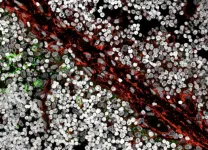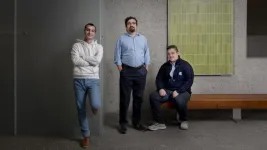(Press-News.org) LA JOLLA, CA—Scripps Research scientists have developed an antibody that can block the effects of lethal toxins in the venoms of a wide variety of snakes found throughout Africa, Asia and Australia.
The antibody, which protected mice from the normally deadly venom of snakes including black mambas and king cobras, is described on February 21, 2024, in Science Translational Medicine. The new research used forms of the toxins produced in the laboratory to screen billions of different human antibodies and identify one that can block the toxins’ activity. It represents a large step toward a universal antivenom that would be effective against the venom of all snakes.
“This antibody works against one of the major toxins found across numerous snake species that contribute to tens of thousands of deaths every year,” says senior author Joseph Jardine, PhD, assistant professor of immunology and microbiology at Scripps Research. “This could be incredibly valuable for people in low- and middle-income countries that have the largest burden of deaths and injuries from snakebites.”
More than 100,000 people a year, mostly in Asia and Africa, die from snakebite envenoming—rendering it more deadly than most neglected tropical diseases. Current antivenoms are produced by immunizing animals with snake venom, and each generally only works against a single snake species. This means that many different antivenoms must be manufactured to treat snake bites in the different regions.
Jardine and his colleagues have previously studied how broadly neutralizing antibodies against the human immunodeficiency virus (HIV) can work by targeting areas of the virus that cannot mutate. They realized that the challenge of finding a universal antivenom was similar to their quest for an HIV vaccine; just like quickly evolving HIV proteins show small differences between each other, different snake venoms have enough variations that an antibody binding to one generally doesn’t bind to others. But like HIV, snake toxins also have conserved regions that cannot mutate, and an antibody targeting those could possibly work against all variants of that toxin.
In the new work, the researchers isolated and compared venom proteins from a variety of elapids—a major group of venomous snakes including mambas, cobras and kraits. They found that a type of protein called three-finger toxins (3FTx), present in all elapid snakes, contained small sections that looked similar across different species. In addition, 3FTx proteins are considered highly toxic and are responsible for whole-body paralysis, making them an ideal therapeutic target.
With the goal of discovering an antibody to block 3FTx, the researchers created an innovative platform that put the genes for 16 different 3FTx into mammalian cells, which then produced the toxins in the lab. The team then turned to a library of more than fifty billion different human antibodies and tested which ones bound to the 3FTx protein from the many-banded krait (also known as the Chinese krait or Taiwanese krait), which had the most similarities with other 3FTx proteins. That narrowed their search down to about 3,800 antibodies. Then, they tested those antibodies to see which also recognized four other 3FTx variants. Among the 30 antibodies identified in that screen, one stood out as having the strongest interactions across all the toxin variants: an antibody called 95Mat5.
“We were able to zoom in on the very small percentage of antibodies that were cross-reactive for all these different toxins,” says Irene Khalek, a Scripps Research scientist and first author of the new paper. ‘This was only possible because of the platform we developed to screen our antibody library against multiple toxins in parallel.”
Jardine, Khalek and their colleagues tested the effect of 95Mat5 on mice injected with toxins from the many-banded krait, Indian spitting cobra, black mamba and king cobra. In all cases, mice who simultaneously received an injection of 95Mat5 were not only protected from death, but also paralysis.
When the researchers studied exactly how 95Mat5 was so effective at blocking the 3FTx variants, they discovered that the antibody mimicked the structure of the human protein that 3FTx usually binds to. Interestingly, the broad-acting HIV antibodies that Jardine has previously studied also work by mimicking a human protein.
“It’s incredible that for two completely different problems, the human immune system has converged on a very similar solution,” says Jardine. “It also was exciting to see that we could make an effective antibody entirely synthetically—we did not immunize any animals nor did we use any snakes.”
While 95Mat5 is effective against the venom of all elapids, it does not block the venom of vipers—the second group of venomous snakes. Jardine’s group is now pursuing broadly neutralizing antibodies against another elapid toxin, as well as two viper toxins. They suspect that combining 95Mat5 with these other antibodies could provide broad coverage against many—or all—snake venoms.
“We think that a cocktail of these four antibodies could potentially work as a universal antivenom against any medically relevant snake in the world,” says Khalek.
In addition to Khalek and Jardine, authors of the study, “Synthetic development of a broadly neutralizing antibody against snake venom long-chain α-neurotoxins,” include Yen Thi Kim Nguyen, Jordan Woehl, Jessica M. Smith, Karen Saye-Francisco, Yoojin Kim, Laetitia Misson Mindrebo, Quoc Tran, Mateusz Kędzior, Oliver Limbo, Megan Verma, Robyn L. Stanfield, Dennis R. Burton, Devin Sok and Ian A. Wilson of Scripps; Evy Boré, Rohit N. Patel, Stefanie K. Menzies, Stuart Ainsworth, Robert A. Harrison and Nicholas R. Casewell of the Liverpool School of Tropical Medicine; and R. R. Senji Laxme, Suyog Khochare and Kartik Sunagar of the Indian Institute of Science.
This work was supported by funding from the National Institutes of Health (R35 CA231991, U01 AI142756, RM1 HG009490, R35 GM118062, R35 GM118069), the Damon Runyon Cancer Research Foundation (2406-20), the Jane Coffin Childs Fund, the Mark Foundation for Cancer Research and the Howard Hughes Medical Institute.
About Scripps Research
Scripps Research is an independent, nonprofit biomedical institute ranked one of the most influential in the world for its impact on innovation by Nature Index. We are advancing human health through profound discoveries that address pressing medical concerns around the globe. Our drug discovery and development division, Calibr, works hand-in-hand with scientists across disciplines to bring new medicines to patients as quickly and efficiently as possible, while teams at Scripps Research Translational Institute harness genomics, digital medicine and cutting-edge informatics to understand individual health and render more effective healthcare. Scripps Research also trains the next generation of leading scientists at our Skaggs Graduate School, consistently named among the top 10 US programs for chemistry and biological sciences. Learn more at www.scripps.edu.
END
Snaking toward a universal antivenom
Scripps Research scientists discovered antibodies that protect against a host of lethal snake venoms.
2024-02-21
ELSE PRESS RELEASES FROM THIS DATE:
New system triggers cellular waste disposal
2024-02-21
Living cells resemble highly organized small towns - in addition to energy production, transportation systems, and construction, cells also require efficient waste disposal. Most proteins, which shape and sustain cellular function, have only a limited half-life and must eventually be disposed of, along with defective and unwanted proteins. This vital task falls upon specialized enzymes known as ubiquitin ligases, which tag obsolete proteins for degradation, guiding them to the cellular recycling center, ...
Possible trigger for autoimmune diseases discovered : B cells teach T cells which targets must not be attacked
2024-02-21
Immune cells must learn not to attack the body itself. A team of researchers from the Technical University of Munich (TUM) and the Ludwig Maximilian University of Munich (LMU) has discovered a previously unknown mechanism behind this: other immune cells, the B cells, contribute to the "training" of the T cells in the thymus gland. If this process fails, autoimmune diseases can develop. The study confirms this for Neuromyelitis optica, a disease similar to Multiple Sclerosis. Other autoimmune diseases may be linked to the failure ...
Detecting pathogens faster and more accurately by melting DNA
2024-02-21
A new analysis method can detect pathogens in blood samples faster and more accurately than blood cultures, which are the current state of the art for infection diagnosis. The new method, called digital DNA melting analysis, can produce results in under six hours, whereas culture typically requires 15 hours to several days, depending on the pathogen.
Not only is this method faster than blood cultures, it’s also significantly less likely to generate false positives compared to other emerging DNA detection-based technologies such as Next Generation Sequencing.
Why ...
MD Anderson research highlights for February 21, 2024
2024-02-21
HOUSTON ― The University of Texas MD Anderson Cancer Center’s Research Highlights showcases the latest breakthroughs in cancer care, research and prevention. These advances are made possible through seamless collaboration between MD Anderson’s world-leading clinicians and scientists, bringing discoveries from the lab to the clinic and back.
Recent developments at MD Anderson offer insights into drug-drug interactions for patients with acute myeloid leukemia (AML) and myelodysplastic syndromes; patient-derived xenograft models as a viable translational ...
Engineers use AI to wrangle fusion power for the grid
2024-02-21
In the blink of an eye, the unruly, superheated plasma that drives a fusion reaction can lose its stability and escape the strong magnetic fields confining it within the donut-shaped fusion reactor. These getaways frequently spell the end of the reaction, posing a core challenge to developing fusion as a non-polluting, virtually limitless energy source.
But a Princeton-led team composed of engineers, physicists, and data scientists from the University and the Princeton Plasma Physics Laboratory (PPPL) have harnessed ...
UChicago scientists invent ultra-thin, minimally-invasive pacemaker controlled by light
2024-02-21
Sometimes our bodies need a boost. Millions of Americans rely on pacemakers—small devices that regulate the electrical impulses of the heart in order to keep it beating smoothly. But to reduce complications, researchers would like to make these devices even smaller and less intrusive.
A team of researchers with the University of Chicago has developed a wireless device, powered by light, that can be implanted to regulate cardiovascular or neural activity in the body. The featherlight membranes, ...
Accelerometer-measured physical activity, sedentary time, and heart failure risk in older women
2024-02-21
About The Study: The results of this study of 5,951 women ages 63 to 99 suggest that promoting regular physical activity and minimal sedentary time may be prudent for primary prevention of heart failure and its subtype with preserved ejection fraction for which treatment is limited.
Authors: Michael J. LaMonte, Ph.D., M.P.H., of the University at Buffalo—SUNY, is the corresponding author.
To access the embargoed study: Visit our For The Media website at this link https://media.jamanetwork.com/
(doi:10.1001/jamacardio.2023.5692)
Editor’s Note: Please see the article for additional information, including other ...
Lifetime suicide attempts in otherwise psychiatrically healthy individuals
2024-02-21
About The Study: In this study using data from 1,948 U.S. adults with lifetime suicide attempts from a nationally representative population-based survey, an estimated 19.6% reported not having met criteria for any psychiatric disorders prior to their first attempt. This finding challenges clinical notions of who is at risk for suicidal behavior and raises questions about the safety of limiting suicide risk screening to psychiatric populations.
Authors: Maria A. Oquendo, M.D., Ph.D., of the University of Pennsylvania in Philadelphia, is the corresponding author.
To access the embargoed study: Visit our For The Media ...
Acupuncture for combat-related posttraumatic stress disorder
2024-02-21
About The Study: The acupuncture intervention used in this randomized clinical trial including 93 participants was clinically efficacious and favorably affected the psychobiology of posttraumatic stress disorder (PTSD) in combat veterans. These data build on extant literature and suggest that clinical implementation of acupuncture for PTSD, along with further research about comparative efficacy, durability, and mechanisms of effects, is warranted.
Authors: Michael Hollifield, M.D., of the Tibor Rubin VA Medical Center in Long Beach, California, is the corresponding author.
To access the embargoed study: Visit our For The Media website at this link https://media.jamanetwork.com/
(10.1001/jamapsychiatry.2023.5651)
Editor’s ...
Study finds high number of persistent COVID-19 infections in the general population
2024-02-21
New study finds that persistent COVID-19 infections are surprisingly common, with around one to three in every 100 infections lasting a month or longer.
Some persistent infections had a high number of mutations, suggesting they could act as reservoirs to seed new variants of concern.
People with persistent infections lasting for 30 days or longer were 55% more likely to report having Long Covid than people with more typical infections.
Reinfections with the same variant were rare.
A new study led by the University of Oxford has ...
LAST 30 PRESS RELEASES:
Anthropologists offer new evidence of bipedalism in long-debated fossil discovery
Safer receipt paper from wood
Dosage-sensitive genes suggest no whole-genome duplications in ancestral angiosperm
First ancient human herpesvirus genomes document their deep history with humans
Why Some Bacteria Survive Antibiotics and How to Stop Them - New study reveals that bacteria can survive antibiotic treatment through two fundamentally different “shutdown modes”
UCLA study links scar healing to dangerous placenta condition
CHANGE-seq-BE finds off-target changes in the genome from base editors
The Journal of Nuclear Medicine Ahead-of-Print Tip Sheet: January 2, 2026
Delayed or absent first dose of measles, mumps, and rubella vaccination
Trends in US preterm birth rates by household income and race and ethnicity
Study identifies potential biomarker linked to progression and brain inflammation in multiple sclerosis
Many mothers in Norway do not show up for postnatal check-ups
Researchers want to find out why quick clay is so unstable
Superradiant spins show teamwork at the quantum scale
Cleveland Clinic Research links tumor bacteria to immunotherapy resistance in head and neck cancer
First Editorial of 2026: Resisting AI slop
Joint ground- and space-based observations reveal Saturn-mass rogue planet
Inheritable genetic variant offers protection against blood cancer risk and progression
Pigs settled Pacific islands alongside early human voyagers
A Coral reef’s daily pulse reshapes microbes in surrounding waters
EAST Tokamak experiments exceed plasma density limit, offering new approach to fusion ignition
Groundbreaking discovery reveals Africa’s oldest cremation pyre and complex ritual practices
First breathing ‘lung-on-chip’ developed using genetically identical cells
How people moved pigs across the Pacific
Interaction of climate change and human activity and its impact on plant diversity in Qinghai-Tibet plateau
From addressing uncertainty to national strategy: an interpretation of Professor Lim Siong Guan’s views
Clinical trials on AI language model use in digestive healthcare
Scientists improve robotic visual–inertial trajectory localization accuracy using cross-modal interaction and selection techniques
Correlation between cancer cachexia and immune-related adverse events in HCC
Human adipose tissue: a new source for functional organoids
[Press-News.org] Snaking toward a universal antivenomScripps Research scientists discovered antibodies that protect against a host of lethal snake venoms.




